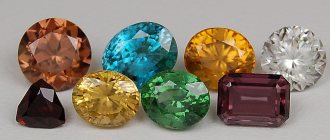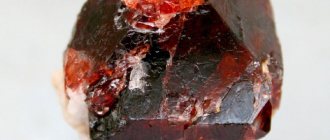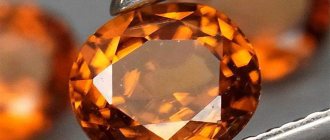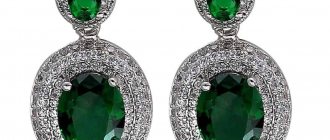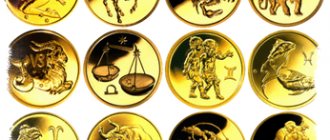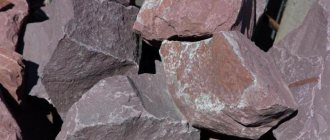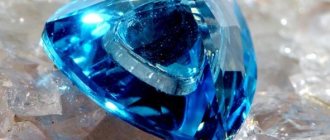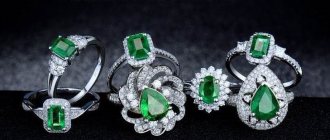What is this chemical element?
Zirconium is part of zircon. Some mineralogists believe that it received its name from its “parent”. And another group of scientists claims that the concept of zirconium goes back to the Arabic language. It can be translated as "cinnabar" or silver color.
Zirconium is considered a trace element because it does not occur separately in the natural environment. In nature, geologists find it as silicate or oxide. The existence of zirconium was proven at the beginning of the 18th century by Berzelius, a chemist from Sweden. The atomic number of zirconium is 40. The chemical element in the table is designated by the symbol Zr (Latin name Zirconium). Cinnabar as a metal was obtained at the beginning of the 20th century in laboratory conditions from zircon. It consists of silver-white rods.
Zircon, zirconium and cubic zirconia.
Zircon and zirconium - sounds similar, but...
Zircon is a natural and very expensive gem, comparable in cost to sapphire, and in beauty and physical properties not inferior to other, more famous gems. This is a transparent stone of various colors with a very strong shine, thanks to which zircon in the East was called “the little brother of diamond.” It is believed that the name of the mineral comes from the Persian word “tsargun” - “golden stone or golden-colored”, apparently from the golden-yellow color of one of the varieties of zircon - hyacinth.
In the Middle Ages, jewelry was already known that was considered “imperfect diamonds.” They had another name - “Mantara stones” (after the place where the mineral was mined in Mantara, on the island of Ceylon). These “imperfect diamonds” differed from ordinary ones in slightly lower hardness and less intense shine after cutting. At that time they did not suspect that it was not a diamond, but a single crystal of zircon.
Many people do not know that zircon (Zircon) and cubic zirconium (Cubic Zirconia, CZ) are completely different stones. What many mistakenly call “zircon” is actually synthesized cubic zirconium oxide, or the well-known cubic zirconia . The name comes from the abbreviation FIAN (Physical Institute of the Academy of Sciences), where this mineral was created in 1972. Cubic zirconia is an artificially grown crystal that imitates a diamond, but with lower characteristics, and is very popular among jewelry connoisseurs due to its bright diamond shine. In recent years, this synthetic stone has established itself as an excellent analogue of precious stones and as the best substitute for natural diamonds. Large and well-cut cubic zirconias are quite expensive and rare in jewelry.
Even synthetic diamonds can be expensive. The imitation material must have all the properties of natural stone, but the most important thing is to be cheap. Cubic zirconium, or “zircon,” which is actually cubic zirconia, grown using Soviet technology, but disguised under these commercial names, is imported from abroad. It is not a diamond at all, not a natural mineral, and not the chemical element (metal) zirconium. Cubic zirconia, painted in any color, creates a unique image with its diamond play that is completely different from any natural stone.
There is an element in the periodic table - the metal zirconium (Zr) the mineral zircon is found in nature - zirconium silicate (actually a salt), which has its own jewelry use, cubic zircon . That is, zirconium, zircon and cubic zirconia are different materials.
Zircon is a natural stone of igneous rocks. It may contain various elements that give zircon different colors. In jewelry, transparent zircon crystals of golden-yellow, reddish-brown, and pink colors are mainly used.
Varieties of zircon: hyacinth (orange or brownish-red), jargon (straw yellow), green zircon. Natural zircon is a rather rare guest in a jewelry store, because these stones are rare, and gem-quality minerals are even rarer. Mining takes place mainly in Ceylon, Burma, and Thailand. Most jewelry zircons are mined from alluvial sand and pebble deposits in placers in Sri Lanka, Thailand and Madagascar. Jewelry zircon deposits are very rare.
When they say “Zircon”, this means natural zircon, and not cubic zirconia, i.e. If you purchase a product supposedly with zircon, but the label says cubic zirconia, then this means that you are not purchasing zircon, but cubic zirconia. Be careful, real natural zircons are quite rare. Not a single normal store or factory will cheat on new products under pain of criminal liability.
Wearing jewelry with zircons requires special attention and caution, as the stone is very fragile and can break easily. Small zircons can quickly lose their luster in jewelry if they are not regularly cared for. It is better not to purchase red synthetic zircons that imitate ruby and spinel, but to look for synthetic corundum (rubies); they have a more marketable appearance, are harder than zircons and are easier to care for.
Metal properties
Synthetically produced zirconium is a silvery-white metal. The appearance of cinnabar is similar to steel. The metal has unique properties that no other natural formation has.
Physical
Cinnabar has the following physical properties:
- thermal conductivity - 23.86 W/(m x K);
- boiling point approximately 4350 °C;
- elastic modulus – 95–97 GPa;
- rigidity – about 600–1700 MPa;
- ability to withstand heating up to 2600 ˚C without deformation;
- density 6.5-10 g per cm3.
Silver-colored metal also has plasticity; it can melt in a vacuum and in inert gases.
Chemical
The most important chemical property of zirconium is its high resistance to corrosion even when exposed to acids and alkalis. But this ability decreases when exposed to high temperatures. Silver-colored metal can also form alloys with other chemical elements.
Biological
Cinnabar also has biological properties. It has a huge positive effect on the human body. The good functioning of some organs depends on zirconium, because it is a bioelement and is included in the structure of their cells. These data were obtained by domestic physiologists quite recently during additional studies of the chemical element. All the positive qualities of zirconium are being studied gradually, and new facts about the silver-colored metal become known almost every year.
Many leading clinics specializing in maxillofacial surgery and traumatology use the latest method. It involves the use of special fixators for multiple bone fractures. These devices hold the fragments together and prevent movement of parts of the bone. This promotes faster tissue fusion, hence faster healing of fractures. These retainers are made from zirconium. Also, alloys of titanium, stainless steel, and cinnabar are used to create various screws, staples, plates, and fasteners, which are used in surgery and even during operations on the brain and spinal cord.
Implants made from cinnabar alloys have many advantages over other materials:
- the ability not to rust even in an aggressive, acidic environment;
- high biological compatibility with any tissue of the human body;
- absence of allergic reactions when cells interact with zirconium objects;
- excellent strength of the clamps, despite the fact that their design is often simple.
Due to their unique structure, alloys have a low density, so products made from them have a lightweight weight. This quality is also valuable in the manufacture of retainers. To all of the above, we can add that the plasticity of silver-colored metal allows you to create devices that fully correspond to the contour of the damaged bone.
Cinnabar does not irritate the surrounding soft and inert tissues, but on the contrary has a beneficial effect on them. Doctors have found that zirconium earrings (put in immediately after the mini-surgery) promote rapid healing of wounds on the earlobes after piercing. The process goes much faster than when wearing gold items.
If you constantly wear jewelry made of silver metal, you will soon notice an improvement in your general physical condition. And weather-dependent people stop reacting sharply to temperature changes and magnetic storms. Doctors have already experimentally established that zirconium products have the following medicinal properties:
- bracelets relieve irritation due to skin diseases and stabilize blood pressure;
- belts help in the treatment of diseases of the musculoskeletal system;
- plates that are applied to joints relieve pain in arthrosis and arthritis.
Even when making dental prosthetics, experienced dentists recommend choosing materials made from cinnabar.
But do not forget that zirconium products are not a panacea for all diseases. You must follow all your doctor’s orders and take your medications. And cinnabar will enhance the effect of traditional medicine.
Physical and chemical properties
Zirconium is a silver-gray metal with a characteristic luster. It exists in three crystalline modifications: hexagonal (α), cubic (β) and metastable hexagonal (ω). Zirconium, free from impurities, is plastic and easy to machine at different temperatures. The fragility of zirconium is explained by the presence in its composition of small amounts of oxygen, hydrogen, carbon and nitrogen. With an oxygen concentration greater than 0.2%, zirconium loses its malleability at low temperatures.
Five natural isotopes of zirconium are known: 90Zr (51.46%), 91Zr (11.23%), 92Zr (17.11%), 94Zr (17.4%), 96Zr (2.8%), and 96Zr is weakly radioactive .
In air, zirconium tends to slowly become covered with an oxide film. It also reacts actively with hydrogen, forming hydrides. In addition, the formation of refractory nitrides at 700-800°C and carbides at temperatures above 900°C is possible. The metal reacts with halogens at temperatures above 400°C, with the exception of fluorine, with which zirconium reacts under normal conditions. Reacts with most acids (for example, nitric and hydrofluoric) at appropriate concentrations and temperatures and is the only metal that is stable in alkalis containing ammonia.
Production methods
The raw material for the industrial production of silver-colored metal was the mineral zircon. First, the mineral goes through the stage of enrichment using the gravitational method, combined with ore purification by separation (electrostatic and magnetic). This process involves sintering the concentrate with lime, calcium carbonate, and soda at high temperatures. Then remove silicon compounds from the sinter. Further decomposition with hydrochloric or sulfuric acid, obtaining zirconium from acidic solutions.
There are other ways to obtain cinnabar from zircon ores, but they are unprofitable due to their high cost.
How to care for zirconium?
Unlike diamonds, which scratch even glass, zircon is a soft stone. Therefore, jewelry with it must be protected from mechanical damage. It is advisable to store them separately from other jewelry. Zircons are very sensitive to household chemicals. They can only be washed with a mild soap solution and wiped with soft napkins or flannel cloth.
Many varieties of zirconium will allow you to choose the stone that you like best. You just have to protect products with it from an aggressive environment and contact with something solid.
Applications of zirconium
Silver-colored metal is used in various manufacturing industries.
- Electrical engineering. Ultra-strong conductors are made from an alloy of zirconium and niobium that can withstand enormous loads. Electronic circuit boards are also coated with cinnabar.
- Nuclear energy. Spare parts are coated with zirconium, from which mechanisms for thermonuclear reactors are subsequently assembled.
- Metallurgy. The metal is used to make parts of steel furnaces that can withstand temperatures of a thousand units.
- Mechanical engineering. Zirconium is becoming a material for creating pumps and fittings that operate in aggressive, acidic environments.
- Pyrotechnics. Fireworks and fireworks using cinnabar emit a significant amount of light energy with virtually no smoke.
- Chemical industry. Zirconium becomes the raw material for metal-ceramic coatings, which have high wear resistance and immunity to acids.
- Optics. The newest lenses are made from cubic zirconia - a material consisting of zirconium processed using a special technology with the addition of rare earth metals.
- Military industry. Cinnabar is used as a filler for flares and tracer bullets.
Silver-colored metal is used in medicine, as described in detail above. And also in the manufacture of exclusive tableware, which is quite expensive. But it has excellent hygienic properties. World-famous fashion designers create original fabrics that have moisture-repellent properties. It turns out that it is provided by zirconium salts that are part of the emulsion with which the material is impregnated. Cinnabar is used in the manufacture of some printing inks and special varnishes.
Zirconium has found its application both in large-scale industrial production and in small workshops in which craftsmen create designer items.
Interesting Facts
Green zirconium metal is capable of accumulating radiation. It is for this reason that it is rarely seen on the store counter. During legal mining, this element must undergo many tests for the presence of harmful substances. Many people believe that zirconium is capable of absorbing positive energy. For this reason, it is used for magical rituals. Besides:
Thanks to the substance zirconium tetrachloride, a pressure gauge was created that can be used to measure pressure in a confined space.- Raincoats have water-repellent properties thanks to zirconium salt. They are also used for the production of printing ink, special varnish and plastic mass.
- High-octane motor fuel is made with the addition of zirconium salts. You should know that they contain tannins.
In addition, the well-known “Nernst lamp” was created thanks to zirconium dioxide. This element emits intense light when heated.
Minerals containing zirconium
Mineralogists are familiar with minerals containing cinnabar:
- Baddeleyite (zirconium oxide). It is used as an additive during the manufacture of refractory ceramics. The mineral also becomes a material for creating artificial diamonds.
- Eudialyte (zirconosilicate). This ore is suitable for the production of rare earth metals and zirconium.
No minerals containing zirconium have yet been discovered in nature. More recently, it was found that sea water also contains zirconium compounds. But scientists have not yet learned how to isolate metal from liquid.
Zirconium: prices, GOST, description
Designation – GOST 21907-76. It is a ductile and malleable (almost like gold), corrosion-resistant, paramagnetic, heat-resistant metal. Zirconium is resistant to sea and chlorinated water, ammonia, alkalis, acids, and does not lose its qualities at low and high temperatures. Mainly used in alloy with other metals. This not only gives it unique properties, but also increases manufacturability. Cost - from 5,500 rubles per kilogram, depending on the brand and manufacturer.
Today, zirconium is classified as a semi-precious stone. In the Middle Ages it was called the brother of diamond, but it lacks the inherent hardness of diamonds.
Cost per gram
The Commonwealth of Australia and the Republic of South Africa have long been the main suppliers of zirconium to the world market. The demand for metal is constantly increasing. And the amount of supplied material remains approximately at the same level. Therefore, its cost is constantly increasing.
At the moment, the price of a gram of cinnabar is about 100-200 rubles.
Zirconium has been known to human society for a century, but it still has not revealed all its secrets to people. It is unclear why the chemical element got its name, or what the full effect of the metal on a living organism is. Probably not all sulfurs are known in which this amazing silver-colored metal can be used.
Biological role and physiological effect
Zirconium does not play a biological role in the body. Metallic zirconium and its insoluble compounds (dioxide, silicate) have high biological inertness (the property of not interacting with tissues and body fluids due to chemical resistance). Nothing is known about the effects of zirconium compounds on the body.
Zirconium dust is a substance with a high fire and explosion hazard, since it can spontaneously ignite in air.
Zirconium bracelets, advertised by V. Kikabidze and supposedly lowering blood pressure, do not have a real therapeutic effect; their possible subjective effect is explained by the placebo effect.
Types of stone
Zircon is rightly considered one of the oldest precious minerals on Earth, because. Scientists have found that the age of this element reaches 3-4 billion years. Currently, several types of zirconium are isolated. The main criterion for this division is the variety of stone colors. The following varieties are distinguished:
- Starlit. A transparent stone, obtained by firing, has a bluish or blue tint.
- Malacon. It is dark brown in color and contains a small dose of radiation.
- Hyacinth. A transparent mineral characterized by brown, orange, and red colors.
- Matar Diamond. Transparent, colorless, extracted from the depths of the island of Matara - hence the name of this variety.
- Jargon. A mineral characterized by a straw, yellow or slightly golden color.
In addition, zirconium can be presented in the form of metal or powder - the scope of their application often differs. For example, the first is used for making jewelry, and the second is used in the medical and industrial fields. More information about these varieties:
- Hard metal. It has a shiny silver-gray tint and has a high degree of plasticity.
- Powder. A characteristic feature is the presence of small granules. Has a dark blue tint.
When heated, Zirconium can change color, allowing jewelers to give finished products a variety of shades. This mineral is:
- white (transparent, the most common);
- blue;
- blue;
- black (extremely rare);
- olive;
- green;
- pink;
- red;
- yellow (has the most pronounced radioactive background);
- brown (weak radiation);
- orange;
- purple.
Receiving technology
Industrial production is aimed at obtaining zirconium metal.
Zirconium Crystals
To do this, zirconium ore is enriched to 61-65% dioxide in its composition. The concentrate is converted using chloride, fluoride or alkaline methods.
The method for producing a technologically pure substance (ZrO2) is based on an alkaline process. The concentrate is sintered, leached, purified, and hydrolyzed.
